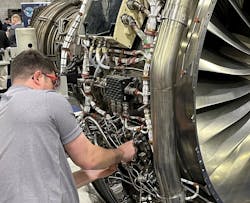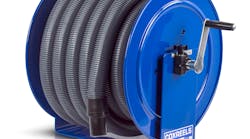Even if they generally have a long lifespan, aircraft hoses come with specific maintenance and inspection requirements. In this feature, we have reached out to industry experts to provide an overview of precautions and best practices for managing both airborne and aviation ground fuelling hoses, inspection requirements, and options for repair and replacement.
Precautions and Practices
From an industry perspective, points out Becky Parsons, general manager of conveyance products and fluid and electrical distribution for aerospace at Eaton, over the years the knowledge has expanded significantly on what one can do on a regular basis to ensure a long lifespan in regard to airborne hoses. “Along with other industry leaders, the SAE Aerospace Committee specifically developed a visual inspection guide and a handling and installation practices guide to share with our customers and any users of these hoses to follow for safety, reliability and longevity purposes,” she says. “These guides help to classify defects into two categories and identify specific defect types, like broken wires or abrasion, and when and how to replace”.
Following the ATA’s aviation ground fuelling hose inspection requirement as well as using devices such as hose beads or hose protective wrap help ensure the longevity of the hose, declares Doug Kerkman, vice-president of Becker Aviation.
As regards aviation ground fuelling hoses, their life and safety are dependent on their daily application and usage, affirms Bill Lesser, global aviation manager of Hewitt, A Husky Company. “If the hose is in constant use and not removed from service, it can last anywhere from six months at major airports to 10 years at the smallest facilities,” he says. “It is the responsibility of the user to conduct at least monthly inspections of hose assemblies for wear, as well as any movement of the fittings on the end of the hoses. In addition, pressure testing of an assembly to a minimum of working pressure should be conducted at least every six months.”
Time to Inspect
For what concerns the conditions of the hoses, affirms Kerkman, aviation ground fuelling hoses are checked routinely - daily, monthly, and during preventive maintenance of the equipment the hose is installed on. “Also, all fuelling hoses have to meet the requirements of the EI 1529, Type C standards or those of EI 1529 Grade 2 Type CT standards for cold temperature hoses,” he says.
According to Lesser, one should immediately discard the hose assembly if it is more than 10 years old, if it indicates general signs of wear, or if it stored for more than two years. “The aviation ground fuelling hose assembly should also be discarded if it is put into service, then removed and not rotated back into service within 15 days, if it shows any movement of the permanent fittings on the end of the hose, or if it is in service with a hose cover that has cracks, nicks, and/or gouges in which the braid or spiral wraps are visible,” he says.
In general, affirms Parsons, any exposed airborne hoses should be inspected during the aircraft walk around prior to every flight. “Naturally, exposed hoses experience some wear and tear a little more quickly, due to environmental factors and hoses within the aircraft body should be inspected during regularly scheduled maintenance checks of the other aircraft systems,” she says. “Ultimately, the user is responsible for making the decision of when to replace the hose and should use their own analysis, testing and review of maintenance records and data. It is important that the user diligently ensures all performance, safety and warning requirements of the application are properly followed. The SAE Aerospace Committee’s inspection guide for installed hose assemblies was designed to help in that determination process.”
On commercial aircraft, polytetrafluoroethylene (PTFE) hoses are normally used, while aircraft rubber hoses are more common on smaller aircraft, explains Parsons. “This is because while PTFE hoses are more expensive, they are generally preferred over other hose types since they are extremely robust and built for extreme environments experienced on commercial aircraft,” she says. “Capabilities for the PTFE hose might include vibration loading, chemical resistance, and temperature extremes, which is why they can be used on multiple systems throughout the aircraft. Once installed, they rarely need to be replaced, unless damaged.”
Repair or Replacement
In the US there are few options to repair aviation ground fuelling hoses in the field, affirms Lesser, so most of the time one just orders a new hose if it is damaged. “If a fitting is damage, one can send the hose back to an aviation hose company like Hewitt for the fitting to be removed and a new fitting to be attached, inspected, pressure tested, checked for continuity and a new certificate is issued,” he says. “Outside of the US, one can make use of reusable couplings to repair damage couplings or, if one wants to shorten the hose, this can be done in the field by a qualified person with knowledge of how to assemble the reusable couplings to the hose. The assembled hose does need to be tested for pressure and continuity prior to use.”
In case of damage to aviation ground fuelling hoses, these can be sent back to approved facilities to perform a pressure test and more thorough inspection of the hose to see if the hose can be recoupled or if a replacement hose is required, according to Kerkman. “Typically, for maintaining equipment uptime, hose replacements are more prevalent than having a hose sent in for inspection or repair. In the US, as the hoses are typically coupled with non-repairable ends, there is no ‘in the field’ repair option for hose coupling ends,” he says.
According to Parsons, due to airborne hose construction, damaged hoses should be replaced, not repaired. “Unlike rigid tube assemblies, hose assemblies are made up of layers of different material and unique structural components, which may be bonded to each other, with end fittings permanently attached in many cases. If there is even a minor indication of damage to a hose, such as kinking, the hose needs to be proactively replaced,” she says. “In the short term, if a minor abrasion is seen, an additional abrasion sleeve can be put on a hose as chafe protection. As always, the application and operating condition matter when evaluating this type of repair, which is not a long-term option for safety and reliability reasons.”




